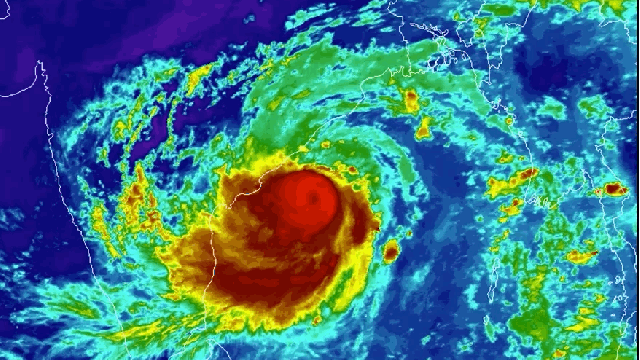Cyclone Fani is bearing down on India and has forced the largest evacuation in the country’s history as millions flee from the coast.
The storm formed in the Bay of Bengal earlier this week and has been gathering steam ever since as it stalks India’s east coast. It’s expected to make landfall on Friday packing a major punch with powerful winds, storm surge, and rain.
As of Wednesday, the storm had top winds of around 249km/h in the most recent Joint Typhoon Warning Center forecast, putting it right on the cusp of a Category 5 hurricane. But more recent satellite estimates indicate its winds could be whipping as high as 267km/h, well above Category 5 strength.
Fani is expected to weaken a bit before landfall, but it could still be a very dangerous storm as it approaches Puri, a city of 200,000 in the state of Odisha, early on Friday morning. The Joint Typhoon Warning Center is forecasting winds of nearly 241km/h just prior to landfall, making Fani the equivalent of an intense Category 4 hurricane.
The Indian Meteorology Department is calling for “very heavy rainfall and extremely heavy falls” to accompany the storm and roughly five feet of storm surge on top of the high tide meaning it is “very likely to inundate low lying areas of Ganjam, Khurda, Puri and Jagatsinghpur Districts of Odisha at the time of landfall.” The storm is also likely to completely tear apart thatched roof houses and create major disruptions in emergency and telecommunication services.
With such a dire forecast, the Indian government has put out an evacuation order for the entire coastline. That means 3.3 million people are leaving the coast in what the AP is calling the biggest evacuation in India’s history. Up t0 11 million people could be evacuated by the time the storm hits.
The state itself is home to 46 million so basically you have a cyclone ploughing into a population the size of Florida and Texas combined. And inland areas won’t be spared from impacts. Fani should still be a tropical storm on Saturday as it moves inland and dumps copious rain. Tropical storm-force winds could even lash Kolkata, the capital of West Bengal home to 4.5 million.
“The Central Government is ready to provide all possible assistance that would be required,” Prime Minister Narenda Modi said in a tweet. “Prayers for the safety and well-being of our citizens.”
India is no stranger to tropical cyclones, which can form at any time of year in the Bay of Bengal. The last major storm to strike this part of the coast Cyclone Hudhud, which came ashore as a Category 4 in 2014. Puri also took a direct hit from an unnamed 1999 Category 5 cyclone, the most powerful on record to hit India with winds of 257km/h just prior to landfall according to records kept by the National Oceanic and Atmospheric Administration (NOAA). Fani isn’t forecast to match that record at landfall, but it’s still likely to pose a catastrophic threat.
NOAA data also shows that water temperatures in the Bay of Bengal are currently 30 degrees Celsius, more than hot enough to sustain such a powerful storm. They’re also running up to 2 degrees Celsius above normal for this time of year, and that excess heat is one of the telltale signs of climate change. That’s not to say Fani is necessarily a sign of climate change, but then it’s becoming more and more challenging to disentangle our weather from our warming world.
The Indian Ocean has also spawned twin cyclones that devastated Mozambique last month.
